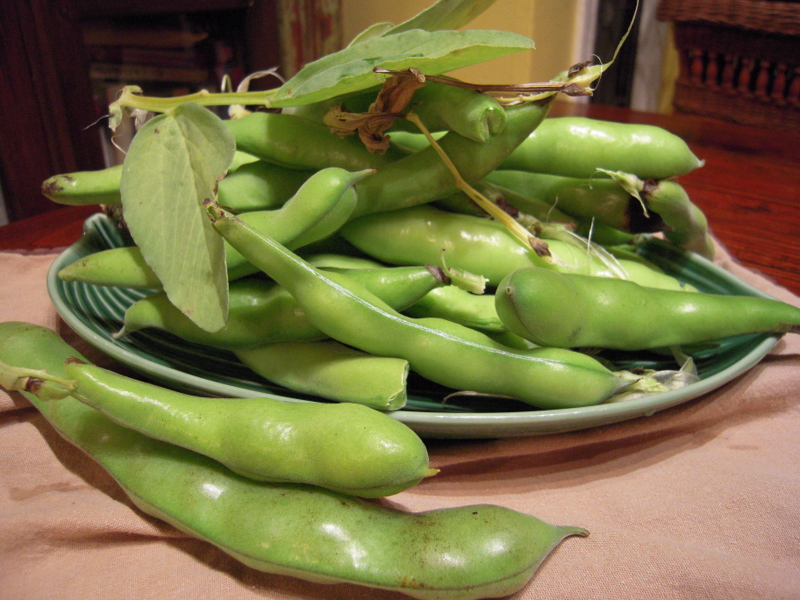
pinto
navy
garbanzo
cannellini
soy
great northern
lima
adzuki
kidney
mung
fava…
Beans are great source of protein. What would vegetarians do without them? Sorry Mr. Pythagoras you were revered for being a great mathematician, mystic and scientist but when it comes to food you just didn’t get it. Why would you refuse to eat beans?!? They are nutritious, delicious, fun and versatile. There are endless ways to make them, whether fresh or dry. I like to go with the season. Of all the beans of Spring, I especially love fresh fava beans.
The favas I used today have a history, and it goes like this. There’s this empty corner lot located next to this gorgeous house that if I was rich or win the lottery I plan on buying someday. Sometime back in cold and rainy January I saw a couple of trucks dumping loads of dirt or compost on the sidewalk by the spot. Later the dirt got artfully spread and a new landscape started taking shape. Suddenly there were charming little peaks and valleys in that tiny place that somehow to my casual gaze looked like a miniature map of San Francisco. Then I thought to myself, “Is this becoming a public garden with a Japanese theme?” It made sense, what with the rolling mini hills and a few leftover stones. It just wanted for some bonsai style pine trees, perhaps a mini red maple and an azalea or two. Bingo! Come on, though wrong, it was a good idea, you have to agree with me.
A couple of weeks went by and I started to see little plants growing in my “Japanese garden.” Pretty soon these started to bloom with beautiful pinkish flowers. Then the pods appeared. Instantly I knew that these were fava. Pythagoras would completely bypass my “Japanese garden.” Legend has it that he was killed while fleeing his persecutors because he refused to cross a field planted with fava for some metaphysical reason. The delay allowed the bad guys to catch up and do him in. Sad, silly man! Didn’t you notice the scent the plants exhale? It is divine! Surely it wouldn’t have harmed you as much as those swords did.
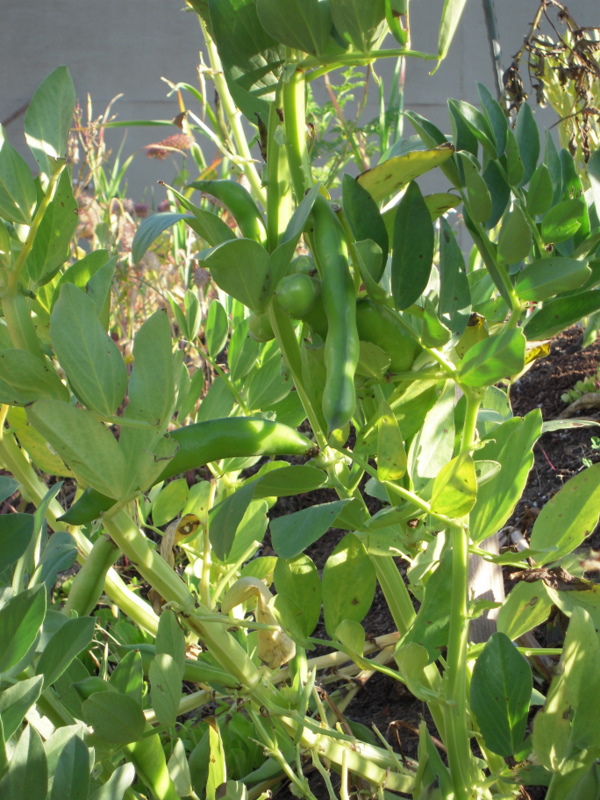
fava plant growing in the pseudo-Japanese garden
Well I kept checking on this mystical garden over the intervening weeks. Last week; those bulging, fat, fuzzy and shiny green pods screamed out to me “take me home.” I succumbed to temptation and harvested a bunch. They were just going to waste it seems, lying forlornly on the sidewalk and ground, ignored by all. So I don’t feel that guilty. We made this traditional Tuscan fava dish in celebration of the wonders of springtime:
Fava Topped Bruschetta
To prepare favas:
1. Start with about two to three dozen fresh fava pods. Peel outer pod off about fava beans.
2. Immerse favas in boiling water for 2 to 3 minutes until outer fibrous shell begins to break open.
3. Drain favas in colander. Run cold water over beans to cool.
4. Peel outer fibrous shell off beans and discard. Inner beans should be bright green. They may break or squish with this step. That’s o.k.
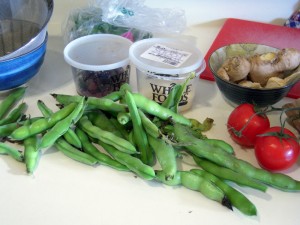
some ingredients to make fava topping
To prepare fava topping:
ingredients
favas from above
¼ cup boiling water
2 to 3 pepperoncini, broken in two
2 tbs. extra virgin olive oil
12 basil leaves, cut in thin strips
2 tbs. shredded parmigiano reggiano
salt and fresh black pepper to taste
Put freshly prepared favas in boiling water. Add pepperoncini and olive oil. Boil for a few minutes until favas are soft. Press the beans to make a paste (I use the base of a highball glass). Remove pepperoncini. Pour beans into small bowl containing basil. Stir until mixed. Add cheese, salt and pepper to taste. Stir again. This version can be spicy. If you prefer less hot, leave out pepperoncini.
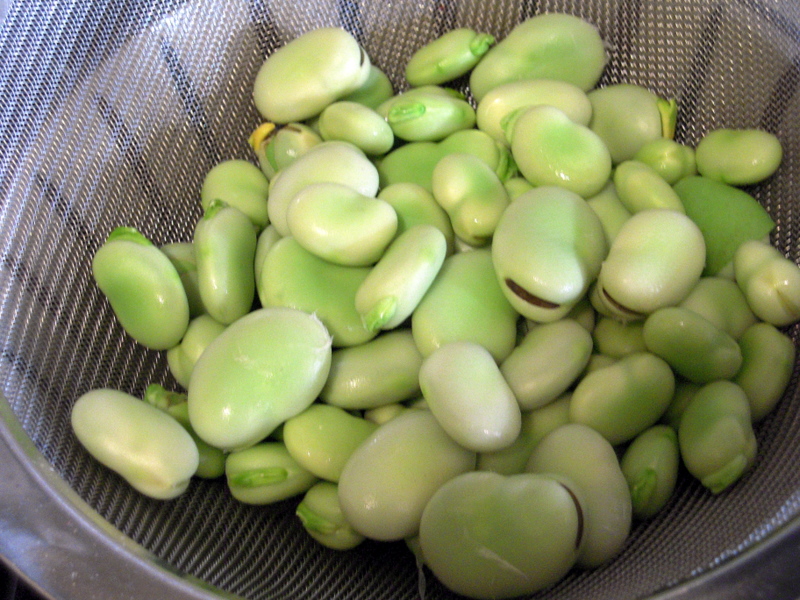
freshly peeled favas still in their fibrous outer shells
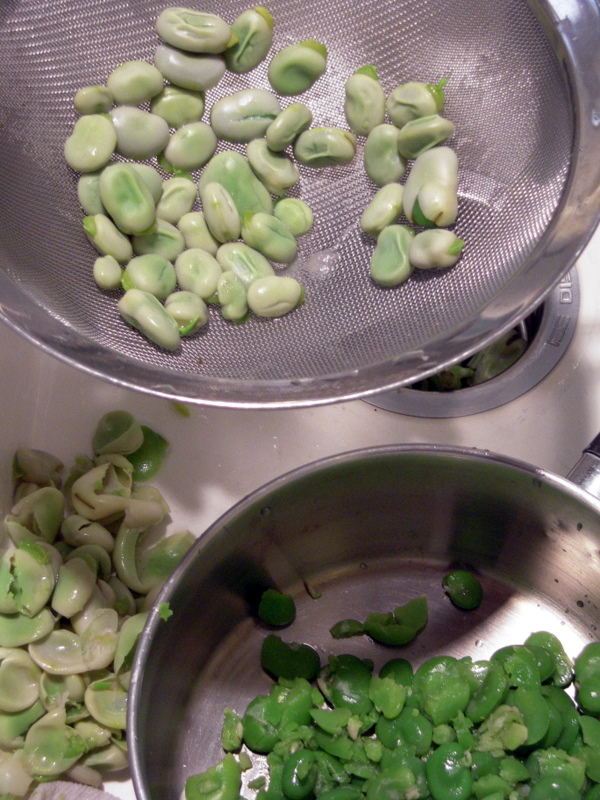
peeling the outer shells off the fava
To make bruschetta:
Take a loaf of rustic bread. We like to use olive bread. Cut in half inch slices. Toast slices on grill or with broiler until bread has medium to dark toast. Remove from heat and place toast on large platter, not overlapping, toasted side up. Rub raw garlic clove on toasted side of bread. Brush or drizzle with extra virgin olive oil. Spoon fava mixture on top of prepared toast.
We like to make this with a tomato and basil topping to complement the color and taste of the fava topping.
To prepare tomato and basil topping:
Dice two to three fresh flavorful tomatoes. This is great with heirloom tomatoes though those are not widely available, especially in winter months. Vine ripe or other eating tomatoes work well. Add tomato dice to bowl with about a dozen basil leaves, thinly sliced as in recipe for fava topping. Add salt and black pepper to taste. Stir. Spoon the tomato topping on alternating slices of bread to make a colorful and very tasty meal or snack.
We often have this with a leafy green salad in a vinaigrette and red wine. If you plan on making this as an appetizer for a large party, cut bread slices in half or thirds before toasting. Then prepare and top these crostini in the same manner as described above.
Let me know what you think about Pythagoras. And thanks to you, the wonderful people of the empty corner lot who had the foresight to plant and abandon the favas in my imaginary “Japanese garden.”
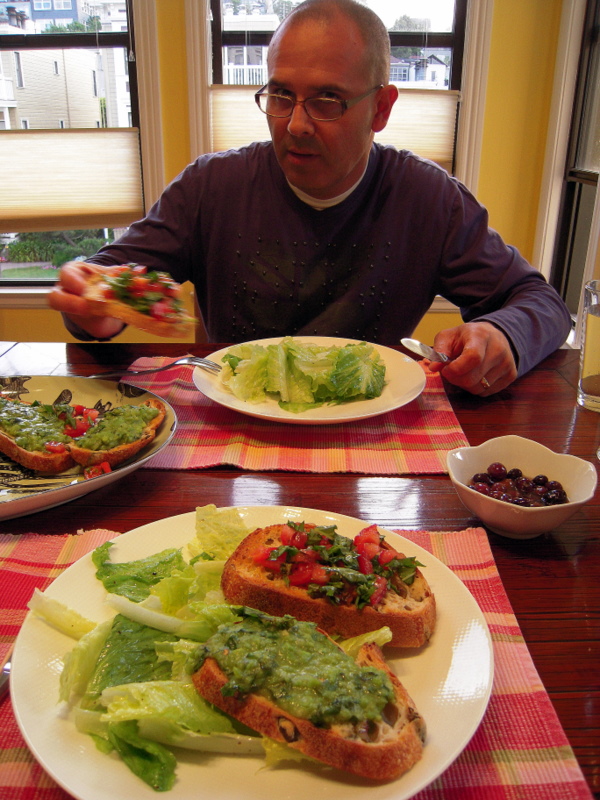
dining on fava and tomato/basil topped bruschetta
Comments on this entry are closed.
Wow, I recall the warm taste of the beans. I love it. Can you buy Favas at the store and make them from a can or something not as fresh? Where can you get them. It seems like a good mix with the tomato and basil!
hello Jasmine,
I would recommend only the fresh fava for this dish. Fava beans are widely available at this time of the year (Spring). Look for it at the veggie section of your local market. Try organic fairs such us the one on Saturdays at the Ferry building in San Francisco if you are from the bay area 🙂
thank you for supporting our blog w/ your reading
WC